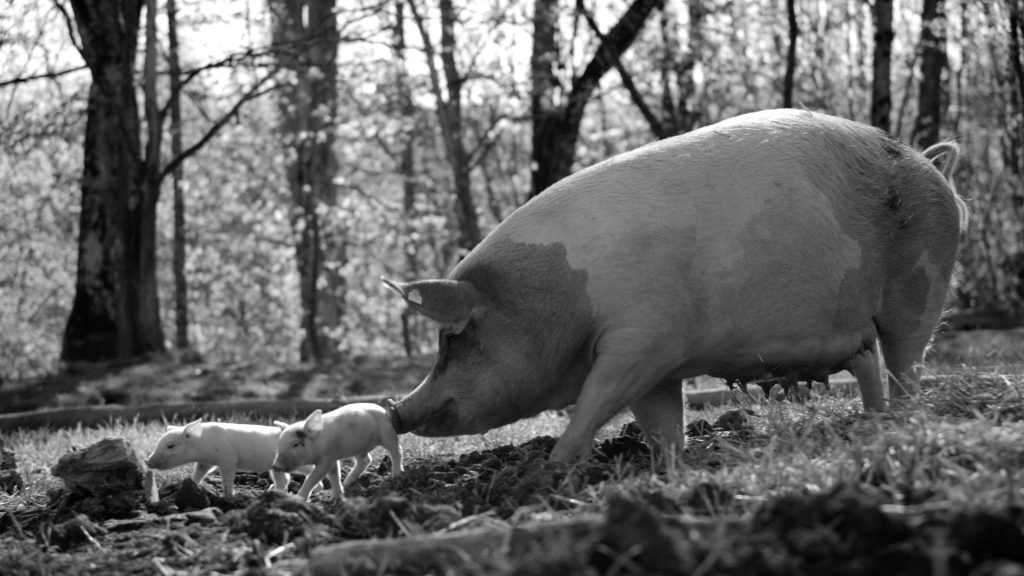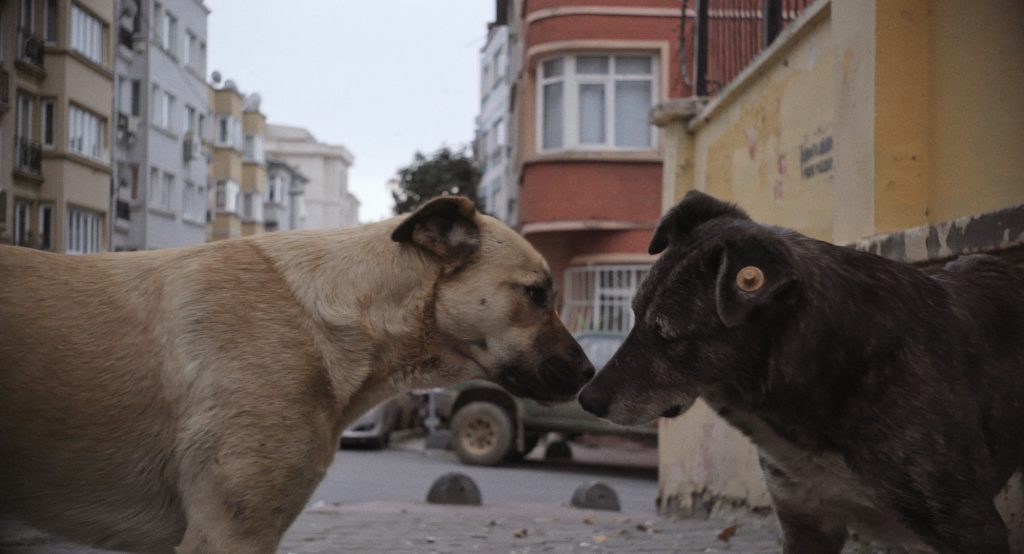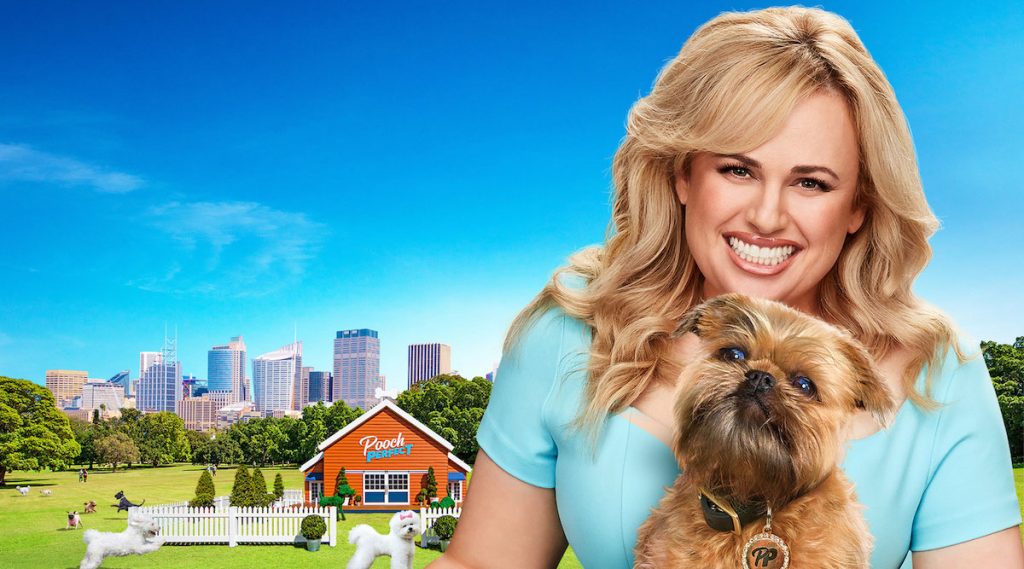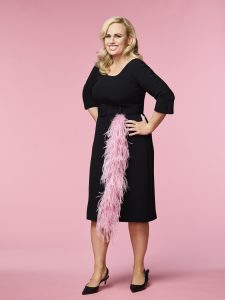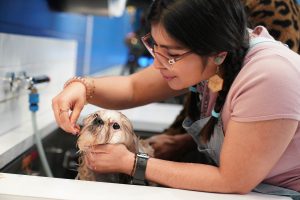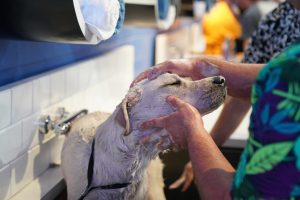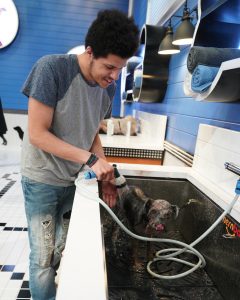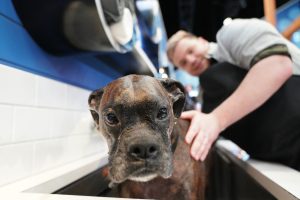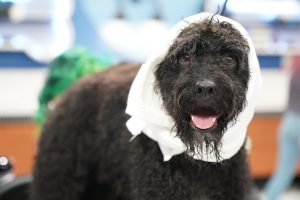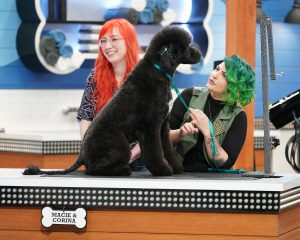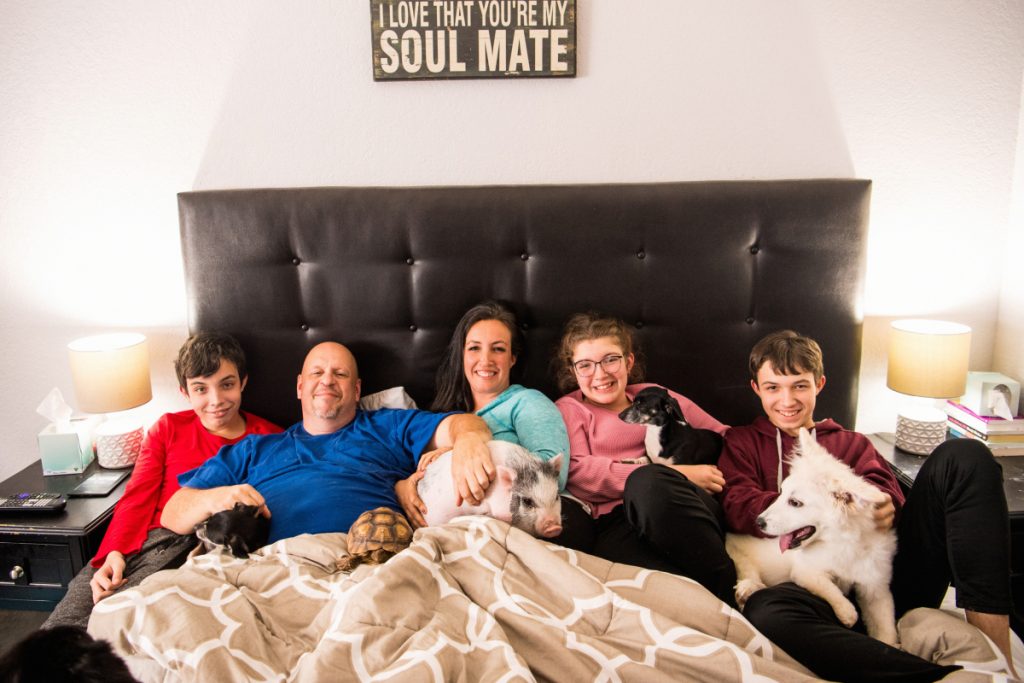May 2, 2021
by Carla Hay

Directed by Richard Boddington
Culture Representation: Taking place in an unnamed Canadian city in Ontario, the family drama “Hero Dog: The Journey Home” features a nearly all-white cast (with one African American) representing the middle-class.
Culture Clash: A blind man who’s stranded on a boat with his sister’s dog decides the best way to get rescued is to walk through the woods with the hope that the dog will lead the way back home.
Culture Audience: “Hero Dog: The Journey Home” will appeal primarily to people who are interested in watching a silly rescue film with terrible acting and a very predictable plot.

Let’s say you’re a blind person with an Alaskan Malamute dog on a boat that’s crashed near a wooded area because the boat’s captain had a heart attack. You, the dog and the unconscious captain are the only living beings on the boat. The crashed boat can be seen by a rescue helicopter that’s sure to be on its way when you’ve been reported missing on the boat. Instead of waiting for the rescue helicopter, you decide to take the dog and walk through the dense woods (where you won’t be seen by the rescue helicopter) because you think the dog will lead you back to your home.
That’s the plot of the mind-numblingly awful “Hero Dog: The Journey Home,” written and directed by Richard Boddington. The movie is so bad that the only heroic thing that the dog does is show some common sense when the humans in the movie make very dumb decisions. Meanwhile, viewers who sit through this junkpile film will either laugh or groan as one absurd thing after another keeps happening. This pseudo-adventure movie really is as corny and stupid and you might think it is.
In “Hero Dog: The Journey Home,” Royce Davis (played by Steve Byers) is the protagonist who makes blind people look bad because the filmmakers want viewers to think that someone who doesn’t have eyesight also doesn’t have common sense. In the beginning of the film, Royce gets on a small boat captained by Fred Boggs (played by Colin Fox), who will be taking widower Royce back to Royce’s family home in the woods, in an unnamed rural part of Ontario, Canada.
Royce has an Alaskan Malamute seeing-eye male dog named Chinook with him on this boat trip. For reasons that aren’t clearly explained in the movie, the dog doesn’t belong to Royce. Instead, the dog belongs to his married sister Susan Wade (played by Natasha Henstridge), who has been taking care of Royce’s two kids while Royce was away on a trip. Apparently, the best way to get to the Davis family’s isolated home is by boat and then by taking a long trek through the woods.
The movie doesn’t say when Royce’s wife died, but his two children are 13-year-old Max Davis (played by Zackary Arthur) and Erin Davis (played by Morgan DiPietrantonio), who’s about 11 or 12 years old. During his conversation with Captain Boggs, Royce mentions that he got a job offer in the city, so the family will be moving there soon. However, Max isn’t too happy about this impending move because he’s an outdoorsy boy who loves the rural area where they currently live. Royce also tells Captain Boggs that he lost his eyesight at age 19, when he was blinded by a roadside bomb when he served in the Afghanistan War.
Not long after the boat sets sail, Captain Boggs has a heart attack, and the boat crashes near an embankment. The boat’s radio can only get static. Royce fumbles for his cell phone and can’t get a signal. Captain Boggs is still alive but unconscious, and Royce doesn’t know how much longer Captain Boggs has to live. Not knowing what to do, Royce waits in the boat until help can arrive. Food and bottled water are in the boat, so he and the dog have enough to survive for at least two days.
Meanwhile, Susan knows something is wrong when Royce doesn’t show up as scheduled, so she contacts the local authorites. Since it’s already night when she reports Royce missing, the police officer in charge, named Captain Walker (played by John Tench), tells Susan and the kids that the rescue operation can’t begin until the morning. Everyone in the family is naturally upset and panic-stricken.
Luckily for Royce, his boat is at an embankment that’s visible from the air. But the next morning, instead of waiting to be rescued, Royce says out loud that he needs to find his way back home so that Captain Boggs can get a chance to get medical help. Royce tells Chinook that they’re going to leave Captain Boggs in the boat and walk through the woods until they find their way back home. It’s at this point in the movie, viewers might be yelling at the screen at how moronic this decision is, but there would be no “Hero Dog: The Journey Home” if Royce acted sensibly in this story.
Before Royce leaves the safety of the boat, he leaves a note to say that he’s going back home. Instead of waiting to be rescued from a boat that can be seen by helicopter, Royce goes into the dense woods with Chinook where they can’t be seen by helicopter and where Royce could possibly fall down and hurt himself. And yes, that fall does happen in the movie. Viewers won’t have much sympathy for this dimwit when it happens.
Meanwhile, Max and Erin think they can do a better job than the adult professionals in finding Royce. And so, they both sneak off to go into the woods to find their father. At first, Erin is reluctant and thinks it’s a bad idea. But when she sees that Max is determined to go with or without her, she huffs, “I can’t let you get all the credit!” And so, off they go with just a backpack filled with the bare minumim of food and supplies.
When Susan finds out that Max and Erin have gone missing, she immediately knows that they’ve gone in the woods to look for their father. Susan wants to go in the woods too, so she can look for Max, Erin and Royce. But then, Captain Walker says the most sensible thing that anyone says in this asinine movie: “Mrs. Wade, I already have three members of your family lost in the wildnerness. I don’t need a fourth.”
Of course, because this movie has to pile on the drama, people who go in the woods encounter wild animals who attack. A mountain lion makes an appearance. In another scene, there’s a wolf. The kids encounter a skunk. This movie is so heavy-handed and unrealistic with the large wild animal encounters, why not bring out a whole managerie of wild animals at this point? Bears need representation too.
Royce and Chinook inevitably get lost. So much for a “hero dog.” One of the worst things about this movie is that during his foolish walk in the woods, Royce brings out a flare gun, which he could’ve easily used when he was on the boat. And then there’s the idiotic scene with Royce trying to start a fire, without any thought of what a disaster it would be to accidentally start a forest fire that Royce can’t put out quickly because he can’t see. It’s not as if Royce has access to any fire hoses or buckets of water.
The scenes with Max and Erin aren’t much better. Erin is a whiny brat, while Max is an insufferable know-it-all. And, of course, it starts to rain and something happens to their backpack of food and supplies. And what is the “hero dog” doing during all of this drama? Just trying to stay alive, while Royce makes one stupid decision after another.
One of these nonsensical decisions is to destroy his cell phone so he can use the mirror interior as some kind of glare signal in the woods, where a glare signal wouldn’t be seen anyway because there are too many trees. Royce is supposed to be someone with military training, but he seems to have no survival skills. The absurdity goes on and on. And so does the bad acting by most of the cast.
Henstridge and Tench are the only cast members whose acting approaches anything close to believable. Everyone else overacts and they sound like they’re reciting lines, not having natural-looking conversations. Everything about this film is done with such unrelenting, self-important ridiculousness, with no humor whatsoever. There isn’t much to like about this movie except the dog. And it’s too bad this innocent dog was forced to be in this embarrassing mess.
Lionsgate released “Hero Dog: The Journey Home” on digital, VOD and DVD on March 23, 2021.

